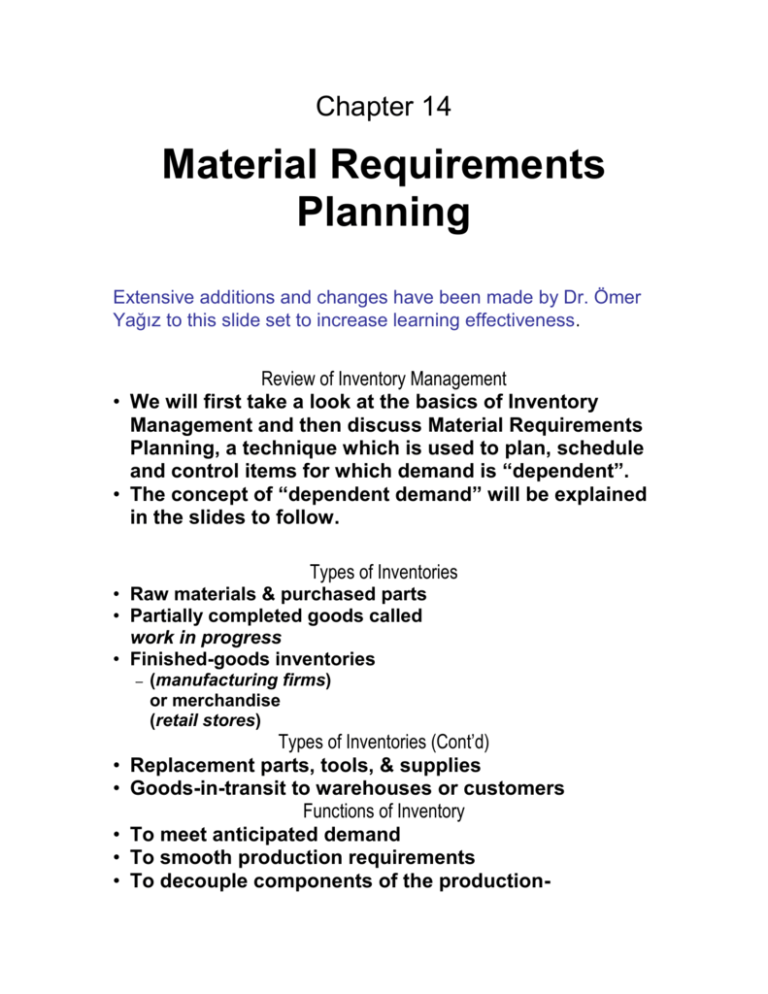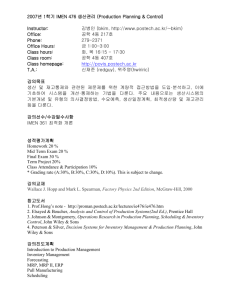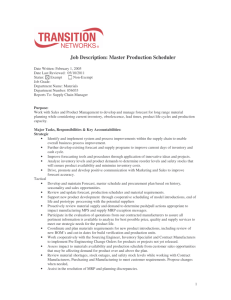Chapter 14 - Material Requirements Planning
advertisement

Chapter 14 Material Requirements Planning Extensive additions and changes have been made by Dr. Ömer Yağız to this slide set to increase learning effectiveness . Review of Inventory Management • We will first take a look at the basics of Inventory Management and then discuss Material Requirements Planning, a technique which is used to plan, schedule and control items for which demand is “dependent”. • The concept of “dependent demand” will be explained in the slides to follow. Types of Inventories • Raw materials & purchased parts • Partially completed goods called work in progress • Finished-goods inventories – • • • • • (manufacturing firms) or merchandise (retail stores) Types of Inventories (Cont’d) Replacement parts, tools, & supplies Goods-in-transit to warehouses or customers Functions of Inventory To meet anticipated demand To smooth production requirements To decouple components of the production- • • • • distribution To protect against stock-outs Functions of Inventory (Cont’d) To take advantage of order cycles To help hedge against price increases or to take advantage of quantity discounts To permit operations (WIP) Inventory Counting Systems • Periodic System Physical count of items made at periodic intervals • Perpetual Inventory System System that keeps track of removals from inventory continuously, thus monitoring current levels of each item Inventory Counting Systems (Cont’d) • Two-Bin System - Two containers of inventory; reorder when the first is empty • Universal Bar Code - Bar code printed on a label that has information about the item to which it is attached ABC Classification System Classifying inventory according to some measure of importance and allocating control efforts accordingly. A - very important B - mod. important C - least important Figure 13-2 The Inventory Cycle Profile of Inventory Level Over Time Q Usage rate Quantity on hand Reorder point Receive order Place Receive order order Place order Lead time • • • • Costs of Inventory Holding (or carrying) costs Setup (or production change) costs Ordering costs Shortage costs Receive order Time Basic Fixed-Order Quantity Model Annual Annual Total Annual Cost = Purchase + Ordering + Cost Cost TC = DC + D Q S + H Q 2 TC D C Q S R L H Annual Holding Cost Total annual cost Demand Cost per unit Order quantity Cost of placing an order or setup cost Reorder point Lead time Annual holding and storage cost per unit of inventory 12 Total Cost Annual Annual Total cost = carrying + ordering cost cost TC = Q H 2 + DS Q Deriving the EOQ Using calculus, we take the derivative of the total cost function and set the derivative (slope) equal to zero and solve for Q. Q OPT = 2DS = H 2( Annual Demand )(Order or Setup Cost ) Annual Holding Cost Figure 13-4 Cost Minimization Goal Annual Cost The Total-Cost Curve is U-Shaped TC Q D H S 2 Q Ordering Costs QO (optimal order quantity) Order Quantity (Q) Minimum Total Cost The total cost curve reaches its minimum where the carrying and ordering costs are equal. EOQ Example Annual Demand = 1,000 units Days per year considered in average daily demand = 365 Cost to place an order = $10 Holding cost per unit per year = $2.50 Lead time = 7 days Cost per unit = $15 Determine the economic order quantity and the reorder point. 14 Solution Q OPT = 2DS = H 2(1,000 )(10) = 89.443 units or 90 units 2.50 Why do we round up? d = 1,000 units / year = 2.74 units / day 365 days / year _ R eorder point, R = d L = 2.74units / day (7days) = 19.18 or 20 units When the inventory level reaches 20, order 90 units. 15 Another Illustration --- Output by Excel W eeks in y ear= Day s in y ear= Annual demand= Order c ost Carry ing c ost= Purc hase pric e= 52 365 1000 9 2 20 weeks day s units $/order $/unit/y ear $/unit EOQ= No of orders= Time bet. orders= Time bet. orders= Time bet. orders= Max Inventory = Avg. Invent.= Tot. Order. Cost= Tot. Carry Cost= Tot. Inv. Cost= Tot. Cost inc Purc . EOQ Q u an tity O r d er C o st 10 20 30 40 50 60 70 80 90 94.86 100 110 120 130 140 150 160 170 900.00 450.00 300.00 225.00 180.00 150.00 128.57 112.50 100.00 94.88 90.00 81.82 75.00 69.23 64.29 60.00 56.25 52.94 94.868 10.54 0.094868 4.93 34.63 94.87 47.43 94.87 94.87 189.74 20,189.74 units orders yr weeks day s units units $/y ear $/y ear $/y ear $/y ear H o ld in g C o st T o tal C o st 10.00 20.00 30.00 40.00 50.00 60.00 70.00 80.00 90.00 94.86 100.00 110.00 120.00 130.00 140.00 150.00 160.00 170.00 910.00 470.00 330.00 265.00 230.00 210.00 198.57 192.50 190.00 189.74 190.00 191.82 195.00 199.23 204.29 210.00 216.25 222.94 The fact that EOQ=Order cost or holding cost is coincidental CO ST BEHAVIO R O F THE EO Q MO DEL 1,000.00 900.00 Order Co st Ho lding Co st 800.00 To tal Co st 700.00 600.00 500.00 C O S T ($ ) 400.00 Minimum of TC curve 300.00 200.00 100.00 170 160 150 140 ORDER QUANTITY (units) 130 120 110 100 90 80 70 60 50 40 30 20 10 0.00 In-Class Exercise Annual Demand = 10,000 units Days per year considered in average daily demand = 365 Cost to place an order = $10 Holding cost per unit per year = 10% of cost per unit Lead time = 10 days Cost per unit = $15 Determine the economic order quantity and the reorder point. 16 Solution Q OPT = d= 2D S = H 2(10,000 )(10) = 365.148 un its, or 366 u n its 1.50 10,000 units / year = 27.397 units / day 365 days / year _ R = d L = 27.397 units / day (10 days) = 273.97 or 274 u n its When the inventory level reaches 274, order 366 units. 17 Dependent vs. Independent demand • Independent demand -- demand for an end item (finished product) that is determined by market forces (price, disposable income, price of substitutes, state of the economy, etc.) Forecasting methods are used for independent demand • Dependent demand - demand arising from the demand for a higher level item NOTE: Dependent demand must be calculated Dependent Demand -- calculated Bicycle(1) P/N 1000 Handle Bars (1) P/N 1001 Frame Assy (1) P/N 1002 Wheels (2) P/N 1003 Frame (1) P/N 1004 Production Planning and Scheduling Framework Aggregate Production Planning Resource Planning Demand Forecasting Master Production Schedule Rough-cut Capacity Planning Detailed Capacity Planning Material Requirements Planning Feedback Purchasing Shop-Floor Control What is MRP? • Material Requirements Planning (MRP) is a production system that is specifically designed to handle dependent demand inventory items. • A computerized inventory control & production planning system • Schedules component items when they are needed - no earlier and no later History of MRP • Begun in 1960 as a computerized approach to production scheduling and purchasing. • Joseph Orlicky, Oliver Wight, and others. • American Production and Inventory Control Society (APICS) launched “MRP Crusade” in 1972 to promote MRP. When to Use MRP • Dependent and discrete items • Complex products • Job shop production • Assemble-to-order environments MRP provides answers for three questions • What is needed? • How much is needed? • When is it needed? • Master Production Schedule (MPS) • Time-phased plan specifying timing and quantity of production for each end item. • Material Requirement Planning Process Figure 14-1 Demand Demand Independent vs Dependent Demand Stable demand “Lumpy” demand Time Amount on hand Amount on hand Time Safety stock Time Time Figure 14-2 MRP Inputs MRP Processing MRP Outputs Changes Order releases Master schedule Planned-order schedules Primary reports Bill of materials file Inventory records file MRP computer programs Exception reports Planning reports Secondary reports Performancecontrol reports Inventory transaction Master Production Schedule (MPS) W eek Item : X 1 2 Q uantity 3 4 50 5 6 7 100 8 200 Figure 14-4 Planning Horizon Assembly Subassembly Fabrication Procurement 1 2 3 4 5 6 7 8 9 10 Master Schedule Master schedule: One of three primary inputs in MRP; states which end items are to be produced, when these are needed, and in what quantities. Cumulative lead time: The sum of the lead times that sequential phases of a process require, from ordering of parts or raw materials to completion of final assembly. Time fences: Series of time intervals during which order changes are allowed or restricted. Bill-of-Materials Bill of materials: One of the three primary inputs of MRP; a listing of all of the raw materials, parts, subassemblies, and assemblies needed to produce one unit of a product. Product structure tree: Visual depiction of the requirements in a bill of materials, where all components are listed by levels. Figure 14-5 Product Structure Tree Level 0 1 Chair Leg Assembly Seat Cross bar 2 Legs (2) Back Assembly Side Cross Back Rails (2) bar Supports (3) 3 Figure 14-6 Low Level Coding Level 0 X B(2) 1 2 3 C D(3) E E(2) E(4) E E(2) MRP Processing • Gross requirements • Scheduled receipts • Projected on hand F(2) • Net requirements • Planned-order receipts • Planned-order releases • Gross requirements: total expected demand for an end item or raw material in a time period • Scheduled receipts: open orders scheduled to arrive from vendors or elsewhere in the pipeline • Projected on hand: expected amount of inventory that will be on hand at the beginning of each period • Net requirements: the actual amount needed in each time period • Planned order receipts: quantity expected to be received by the beginning of the period in which it is shown • Planned order releases: planned amount to order in each time period - planned order receipts offset by lead time Figure 14-9 Assembly Time Chart Procurement of raw material D Fabrication of part E Subassembly A Procurement of raw material F Procurement of part C Final assembly and inspection Procurement of part H Fabrication of part G Procurement of raw material I 1 2 3 Subassembly B 4 5 6 7 8 9 10 11 Illustration (Textbook) M A S TE R P R O D U C TIO N S C H E D U L E W eek Num ber 1 2 3 4 Q u a n t it y 5 6 7 8 100 150 S hutter F ra m e s (2 ) W ood S e c t io n s (4 ) M A S TE R P R O D U C TIO N S C H E D U L E W eek Num ber 1 2 3 4 Q u a n t it y Shutters (LT= 1 wk) 5 6 7 8 100 1 2 150 3 4 5 6 7 8 G R O S S R E Q U IR E M E N TS 0 0 0 100 0 0 0 150 S C H E D U L E D R E C E IP TS 0 0 0 0 0 0 0 0 P R O JE C TE D O N H A N D 0 0 0 0 0 0 0 0 N E T R E Q U IR E M E N TS 0 0 0 100 0 0 0 150 P L A N N E D O R D E R R E C E IP TS 0 0 0 100 0 0 0 150 P LA NNE D O RDE R RE LE A S E S 0 0 100 0 0 0 150 0 Fram es (LT=2 wks) 1 2 3 4 5 6 7 8 G R O S S R E Q U IR E M E N TS 0 0 200 0 0 0 300 0 S C H E D U L E D R E C E IP TS 0 0 0 0 0 0 0 0 P R O JE C TE D O N H A N D 0 0 0 0 0 0 0 0 N E T R E Q U IR E M E N TS 0 0 200 0 0 0 300 0 P L A N N E D O R D E R R E C E IP TS 0 0 200 0 0 0 300 0 200 0 0 0 300 0 0 0 P LA NNE D O RDE R RE LE A S E S W ood Sections (LT=1 wk) G R O S S R E Q U IR E M E N TS 1 2 3 4 5 6 7 8 0 0 400 0 0 0 600 0 S C H E D U L E D R E C E IP TS 70 0 0 0 0 0 0 0 P R O JE C TE D O N H A N D 70 70 70 0 0 0 0 0 N E T R E Q U IR E M E N TS 0 0 330 0 0 0 600 0 P L A N N E D O R D E R R E C E IP TS 0 0 330 0 0 0 600 0 P LA NNE D O RDE R RE LE A S E S 0 330 0 0 0 600 0 0 Updating the MRP System • MRP is not static; it is a “living” document – completed orders – nearing completion – new orders – changes to orders (quantity, delays, missed or late deliveries) Two basic systems of updating • Regenerative system – update MRP records periodically – batch type updating • Net-change system – update MRP records continuously – only changes are updated MRP Outputs (Primary Reports) • Planned orders - schedule indicating the amount and timing of future orders. • Order releases - Authorization for the execution of planned orders. • Changes - revisions of due dates or order quantities, or cancellations of orders. MRP Secondary Reports • Performance-control reports • Planning reports • Exception reports Other Considerations • Safety Stock • Lot sizing – – – – Lot-for-lot ordering Economic order quantity Fixed-period ordering Part-period model Capacity Planning Capacity requirements planning: The process of determining shortrange capacity requirements. Load reports: Department or work center reports that compare known and expected future capacity requirements with projected capacity availability. Figure 14-17 MRP Planning Develop a tentative master production schedule Use MRP to simulate material requirements Convert material requirements to resource requirements Revise tentative master production schedule No Is shop capacity adequate? No Can capacity be changed to meet requirements Yes Firm up a portion of the MPS • • • • Benefits of MRP Low levels of in-process inventories Ability to track material requirements Ability to evaluate capacity requirements Means of allocating production time Yes Change capacity Requirements of MRP • Computer and necessary software • Accurate and up-to-date – – – Master schedules Bills of materials Inventory records • Integrity of data MRP II (Manufacturing Resources Planning) • Expanded MRP with and emphasis placed on integration – – – – – Financial planning Marketing Engineering Purchasing Manufacturing Figure 14-19 Manufacturing Master Master production productionschedule schedule Marketing Production Production plan plan MRP Rough-cut Rough-cut capacity capacityplanning planning Capacity planning Adjust Adjust production productionplan plan Yes Problems? Problems? No Requirements Requirements schedules schedules No Problems? Adjust master schedule Market Demand Finance Yes




